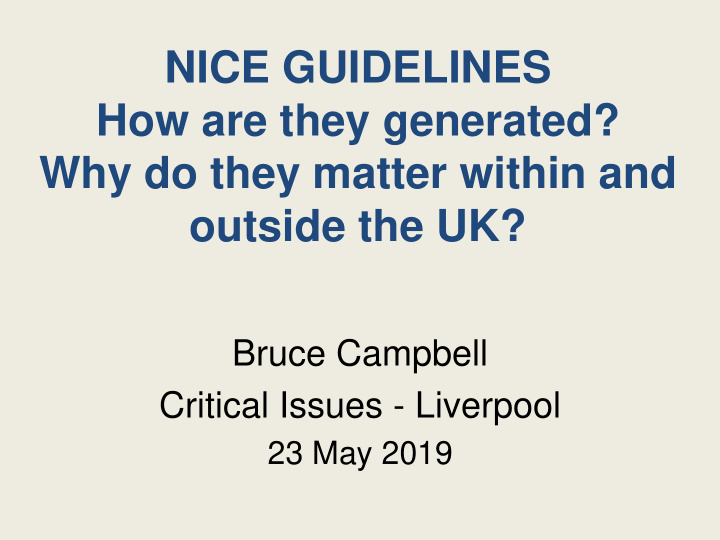



NICE GUIDELINES How are they generated? Why do they matter within and outside the UK? Bruce Campbell Critical Issues - Liverpool 23 May 2019
Confessions • Past Chair NICE Advisory Committees - Interventional Procedures (2002-15) - Medical Technologies (2009-15) • Medicines and Healthcare products Regulatory Agency (MHRA) - Non-Executive Director [devices] (2015-21) • Vascular Surgeon
Why is there concern? Recent NICE draft AAA guideline: • “Do not offer EVAR if surgical repair is suitable …. or if they are unfit for surgery”
… out of tune with established current practice, UK and worldwide Vascular Society considered that the draft • Gave undue emphasis to just one RCT • Considered long-term outcomes only • Focussed on cost-effectiveness • Failed to take account of patient preferences • Ignored implementation and training issues • Used outdated evidence
Examining the AAA controversy VSGBI made points & said “old data”, so NICE • Put new VS data into its cost model and produced the same conclusions • Consulted with interested parties • Sought & introduced additional evidence • Re-convened the Guideline Committee
…. Watch this space ….
NICE guidance on procedures and devices Interventional Procedures: Safety & efficacy (not cost) Technology Appraisals: Clinical & cost effectiveness – the only mandatory guidance for the NHS Medical Technologies: device/diagnostic adoption Clinical Guidelines - Managing specific conditions - Link to Quality Standards
NICE guidance on EVAR Interventional Procedures: IPG10 – 2003 IPG 163 - 2006 Technology Appraisals: TA 167 – 2009 Medical Technologies: If manufacturer chooses Clinical Guidelines: Current (was due 2018)
Principles of producing NICE guidance • Evaluations based on wide range of evidence – Published evidence – Expert advice – Patient experience – Other stakeholders • Independent advisory committees • Explicit and transparent processes • Public consultation • Opportunity for appeal/resolution • Publication
Different types of NICE committees Standing Advisory Committees (TA/IP/MT) • Members/Chair appointed for 3 years (-10 years) • Wide range of interests/expertise • Chair not “specialist” (leaves if any possible conflict) Become very experienced over wide range of topics Clinical Guideline Committees (formerly Guideline Development Groups – GDGs) • All appointed for that guideline topic only • Chair is a “specialist” Therefore less experienced
Development of AAA guideline • Feb 2015 – Topic agreed with DH • April 2015 – Recruitment of Chair and Members • June-August 2015 – Drafting scope • August 2015 – Consultation on scope • November 2015 – Scope published • July 2016 Equality impact assessment published • November 2016 - Pause • April 2017 – Committee meeting • May-June 2018 – Consultation on draft guidance • February 2019 – Additional Committee meeting …
…. the present situation • Very unusual • NICE has all it can get from the Committee • Significant of external input • NICE well aware of the controversy Will the guideline be published …and when?
My observations/inferences when Clinical Guidelines have caused controversy in the past… • Commonly just one aspect is controversial • Often about “advances” in practice when clinicians are being slow (e.g. U/S for central lines) • Chair may be very influential
Why NICE guidelines matter in the UK Generally accepted as the “gold standard” • Slow start in early 2000’s but – Big media attention – Close involvement of specialist societies, etc. • TA recommendations mandatory for the NHS • Now embedded in NHS & health professions • “ Awaiting the NICE guideline ” is common • Expectations of Care Quality Commission • Influential medicolegally
NICE guidance overseas • NICE pioneered cost effectiveness (cost per QALY) • Very many website hits every day (USA etc) • Manufacturers: “ Approved by NICE ” important worldwide • Some countries simply use NICE guidance
NICE guidance overseas - services for other countries Adaptation • NICE sells selected content or full guidance • Adapted, under licence, using ADAPTE etc. • Combine with other guidance, add local content • Translated • NICE does not QA or co-badge • Clients include: Australia, Canada, Ireland, Germany, Saudi Arabia, South Korea, Spain, Tunisia
NICE guidance overseas - services for other countries Contextualisation • Bespoke service using NICE guideline content for de novo guideline development • Allows new locally-relevant guidance to be produced quite quickly • NICE advises on scope, GDG, stakeholders, etc. • Input and review by NICE • Co-badging permitted
Conclusion • NICE guidance development - independent, evidence-based, robust, transparent processes • 95%+ NICE guideline content not controversial • I think the AAA controversy is due to selective emphasis the Committee has chosen to place on aspects of the available evidence • A most unusual situation now exists ….Watch this space….
Recommend
More recommend